|
Latest Bulletin |
|
|
The Red Sea and Home |
|
|
The Red Sea is notorious amongst yachtsmen for the strong winds which funnel up and down its length, and for its steep seas. In the northern half the winds blow strongly and almost constantly from the north, lessening slightly in the early part of the year. So our aim was to be up in Suez, at the southern end of the canal by the end of April. The Red Sea is only about 1500 miles long, but one is advised to allow two months for a reasonably comfortable passage, allowing both time ashore and then time to wait at anchor for the stronger northerlies to abate. We sailed from Aden on March 3rd, heading towards the entrance to the Red Sea - Bab el Mandeb, which translates as The Gate of Tears perhaps for the strong winds which funnel through here. Just after we left Aden, we passed three fishing boats together, and wondered if they were going to approach closely and be a problem, but in the event they passed well clear. As you approach the Bab, the shipping increases, and there is a formal traffic separation zone through the strait itself. We wanted to arrive in the strait in daylight, so spent the night after leaving Aden dodging ships which seemed to appear from all directions. They were just like London buses, arriving in batches, so while John had one of his busiest watches of the entire trip that night, Helen's note in the log recorded low levels of shipping. We had aimed to sail across the southern end of the strait and across both shipping lanes before turning north to sail up the western shore. In the event, we found ourselves in the gap between the two shipping lanes with streams of ships on either side and decided to sail up the gap - the separation zone - to begin with and entered the Red Sea at 0640 on March 8th, with a good wind behind us up to about 35 knots, and well reefed twin headsails. We passed an unidentified frigate heading south, and later that morning met an American "group" consisting of submarine at conning tower depth followed by a frigate (The_Red_Sea_and_home_01) and with a helicopter flying ahead of them to clear their path. We were heading between the sub and the frigate, which seemed to upset them, and they asked us to turn due east straight into the wind and out of their way! We said we couldn't, but did agree to alter course as much as conditions allowed, and enough to pass close astern of the frigate. Just after this we spotted a dhow (The_Red_Sea_and_home_02) bucketing its way across the waves under a very small sail, and were pleased we were in Flame! It was quite a swirly ride for us, and wet too, with the spume being blown off the tops of the waves, though the sea was still relatively flat for the wind speed. By mid afternoon, as we drew away from the strait, the wind had moderated to about force 5 and we celebrated a good start to crossing our penultimate sea. Meanwhile our most successful loaf yet had been rising peacefully in the pressure cooker chocked in the cockpit - another cause for celebration! We kept close in to the western side, thinking we would be clear of the main shipping routes, but to our surprise we found a large ship overtaking us to port as we sailed through a channel round the rocky Haycock Islands. The wind died away overnight, leaving the sea so calm that even pale stars were reflected in the water, looking like individual points of phosphorescence. The dolphins playing around the bow showed long phosphorescent trails, making a spectacular display. The following morning we dropped anchor at curiously named Port Smyth on Shumma Island in Eritrea. We were the only yacht in the anchorage, and took care conning our way in on a course relative to a ruined stone beacon, hoping we had identified it correctly. |
|
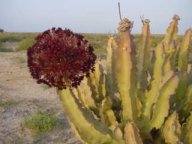
|
The island was a delight, covered in scrubby growth, including these marvellous flowering cacti, with good fishing on the reef and wonderful overhanging coral rocks on the beach. We spent a couple of days relaxing here in the peace and quiet and then moved on to Massawa. We were making our first experiment with tracking our way into the anchorage on GPS and following the track back out again, which we knew we would have to use further north. Having been ashore and identified two ruined beacons which could be held in line, we decided that we knew better than the GPS and touched the reef on the way back out - a useful lesson. On the way up to Massawa, the main port for Eritrea, we saw our first pelicans since Australia. |

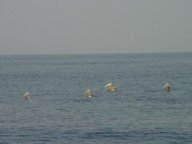
|
|
|
Massawa still bears very clear signs of its war of independence with Ethiopia, with beautiful Italianate buildings in the old town ruined and displaying large shell holes. Despite all of this, the old town, which is closest to the harbour, is an attractive place in a ramshackle way. While we cleared in, we met Mike, who makes it his business to look after yachtsmen - he started a laundry service a few years ago and now helps with re-fuelling; collecting water from the desalination plant; providing transport up to Asmara, the capital, and a host of other invaluable services, all in a delightfully friendly manner. Massawa is a strange port with a mixture of UN ships unloading food aid alongside normal trading vessels. The Ethiopians are still trying to win control of the southern port of Asab. We decided to travel up to Asmara, the capital and arranged a van and driver, and teamed up with Ray and Dee on the American yacht Sajudis, who had arrived in Massawa on the same day as us. |
|
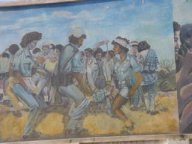
|
Our driver Petros was on leave from the Eritrean Army and apart from pointing out various sights on the spectacular drive up 7,500 feet to Asmara, gave us a stirring account of the progress of the fight by the Eritreans up into the mountains, against the Ethiopian conscript army which initially held the heights. Later in Asmara in the museum there, we encountered the same pride in their achievement, which was having started with no arms at all, slowly capturing from the Ethiopians the means to fight and win, progressing from rifles to tanks to finally, in 1990, a (working) helicopter. Many young women fought alongside the men, whilst others supplied the soldiers in the mountains. The propaganda posters and murals were still very much in evidence, as this one, part of a row of several in Asmara showing the fighters relaxing in a dance. There is such pride in their achievement and Petros' eyes sparkled as he described the capture of weaponry and the gradual success of the campaign. |
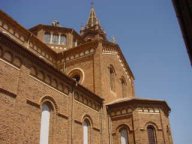
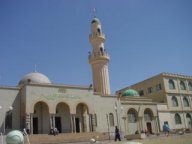
|
|
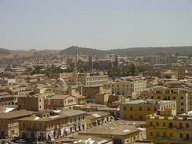
|
The capital is still very Italian in feel and food, though rather over-run by the UN presence, and quite cool by contrast with the intense heat in Massawa - anyone who can afford it sends small children from the coast to stay in Asmara during the blistering summer months (just south of Massawa is said to be one of the hottest places on earth). We all spent some time exploring the town, visiting the Catholic cathedral, the Coptic cathedral, and passing but not entering some beautiful mosques. We were lucky in finding a curate who took us to the top of the bell tower of the Catholic cathedral, with wonderful views both near and far and enjoyed the peace of the inside too. Parts of Asmara are very beautiful, with big houses surrounded by spectacular flowering trees and shrubs and Petros also took us to see newly built suburbs - very pleasant low blocks of flats with communal gardens - there is clearly a lot of investment coming from somewhere. To find this café society with people relaxing with a drink on the pavements in the sun strained the senses a little, particularly when just round the corner donkey carts were ferrying farmers' produce to the market. |
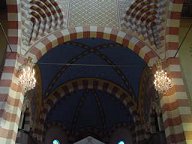
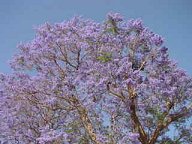
|
|

|
We took the opportunity to stock up in the market and at an Italian supermarket, as it was potentially a long time to the next opportunity to do so, and returned back to the heat of Massawa. On the outskirts we stopped briefly at the British war cemetery from the battle to oust the Italians in 1941 - beautifully kept as always, with the climate necessitating a gravel garden. Petros was stunned to discover that a full time gardener is paid by Britain to tend the graves, after all these years, particularly since he had never heard of the battles that took place, not so very long before the fight for independence. |
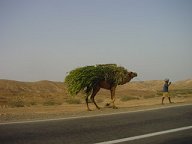
|
Back in the plains, we encountered working camels (in contrast to all the roaming camels we had encountered in Oman) and this nomad, with all his belongings strapped to his camel - food on the side you can see, water, "tent" and poles (sticks) on the other side. Arriving back in Massawa, Petros took us to see the war memorial celebrating the capture of Massawa from the Ethiopians, which with the assistance of tanks, finally took place some 17 years after the first attempt, made with rifles only. He was keen for us to see the full glory of the memorial, so persuaded the attendant to show us how they have plumbed the tanks so that they play water from their turrets! |
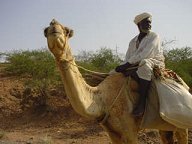
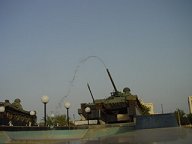
|
|
|
We had stopped at a small café in a village for a drink on the way back and arriving in Massawa Helen realised that she had left her straw hat behind, which was to illustrate great kindness on the part of many people. The village (where the bus queue consisted of several people with their goats) was several hours drive from Massawa, but between them Petros and Mike subsequently found a way to retrieve the hat, and gave it to Ray and Dee on Sajudis, who left a few days after us, to bring north - not one's ideal parcel being both cumbersome and slightly fragile. Returning to the boat, we found that the wind had started to blow intermittently from the north or northwest - until now, it had been either calm or more or less southerly, and in March one still has a sporting chance of southerlies as far as Port Sudan, some 290 miles to the north of us. This was also the point that our PC developed a virus and would do nothing at all. Once ready to go, we decided to chance the weather and leave one afternoon, when the north westerly wind had eased slightly, so we set off, motor sailing northwards into a choppy sea and about 12 knots of wind. We were lucky that the wind went southerly the following morning and we had a good sail for 24 hours with the wind behind us, reaching the border between Eritrea and Sudan, when the wind died away and then went back into the north and increased rapidly. Since our route took us through a maze of islands and we knew there were problems with the accuracy of the charts, we decided not to try to tack up through them. The rule of thumb when sailing up the west coast of the Red Sea is that you must be in your anchorage by 2 or at the latest 3pm while the sun is still high enough for you to see the reefs and steer a safe course between them. Once the sun is past its highest, the water becomes opaque, and there are few or no markers to guide you in. So we turned and headed for Trinkitat, in Sudan, a sheltered bay which is described in recent pilotage notes as a military harbour and not recommended. We therefore had our excuses for stopping at the ready. Entering the anchorage past a reef and through a narrow unmarked entrance, it was hard to see any obvious sign of military installation, although there were a few buildings ashore and a rather battered looking small grey patrol boat up on the beach. We were taken aback to see what appeared to be one or two very tall people on the sand dunes ashore, which we concluded was due to a sort of mirage effect. Soon after we had anchored, a large low open boat approached, having some difficulty manoeuvring as the outboard seemed only to work in reverse and the throttle was controlled by a man with a spanner held to the engine. However they finally passed us a very short piece of line and we tied them up alongside, well fendered as there was quite a chop even in the anchorage. There were four men on board, none in uniform, but a swivel gun was mounted in the centre of the boat, still roughly covered in its tarpaulin. One man came aboard, who spoke very reasonable English - he told us that we were in a military harbour, and that we could stay for a couple of hours! We explained that we "needed" more time, and he eventually agreed that we could stay overnight. We volunteered that we would not unpack the dinghy, whereupon he told us that if we went ashore we would be gaoled! It was a pretty cold and windy day by now, so we hardly even went up on deck during the afternoon, and were left in peace till the following morning, when the boat came alongside again with rather more force and smashed a part of our wooden toe rail in the process. However they had come to agree that we could stay one more day (John had tools scattered about the floor and the engine cover off) and even said we might if we wished go ashore that afternoon. Since it was still blowing and choppy and we were unsure if they would change their minds again, we decided not to take advantage of that offer, and the following morning, before they could visit us and cause more damage, we set off again, thanking them by radio, though there was no sign of anyone listening. |
|
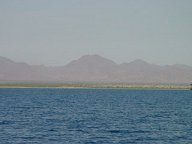
|
We decided to take an inshore passage which would take us close along the coast line and mean that we would have to stop every night as we navigated inside the barrier reef. Our first stop was at a reef anchorage in the Shubuk Channel, which was charted in the 19th century and has hardly been updated since, and then we threaded our way through, sailing more or less due west in nice flat water navigating using a combination of GPS references from the updates to the pilot book, beacons which surprised us by being in place, and the chart, though the three didn't tally very well with each other! Just after the coast turned north again, we entered our first marsa. These are inlets in the fringing reef of varying size and length which offer generally good shelter from the sea, and sometimes from the wind. Some have a beacon to mark the entrance, but in all cases eyeball navigation is required - one of us stands up on the boom for the best view with the handheld GPS, giving directions to the helmsman, who in the bright sunlight can also see the blue channel between the brown reefs, but not so far ahead. This is where mast steps or even a crow's nest would be handy! This picture gives you an idea of how little there is to go on as you arrive in the offing of one of these marsas! When you leave in the morning, you follow the GPS waypoints back out again, allowing you to make an early start before the sun is high enough for you to see the route - a potentially risky tactic. (Waypoints are like the points at which children in fairy stories drop crumbs to mark the route home through the forest, except that generally they should be more reliable!). |
|
Out next stop was a marsa with a more tortuous entrance, and Helen captured 30 waypoints on the GPS to mark the route. We had caught a small barracuda on the way in and decided to barbecue it ashore. So we used the dinghy to check the route and reduced the number of waypoints by about half before walking over desert salt marsh to admire a flock of flamingo while collecting firewood. The following morning we left before the sun had started to rise (coming back out of marsas, heading eastwards straight into the low sun made us even more blind) following the waypoints back out, with relief once we were through. |
|
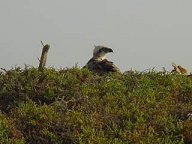 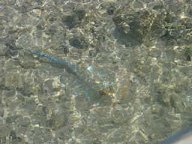
|
We stopped in one more very small marsa - hardly more than a scoop in the coral - before making a rather difficult wandering entrance, with misleading leading lines taking us over very shallow coral heads, into the highly recommended Marsa Fijab. We calculated that we were half way up the Red Sea, though we had undoubtedly completed the easy half! Since leaving Trinkitat we had been motoring or motor sailing in pretty flat seas, but as we went into Marsa Fijab, the wind started to rise, and we were very pleased not to have still been in the previous small marsa, which could not have been very sheltered as the sea rose. Furthermore, Marsa Fijab is famous for its bird life, and we were delighted to be surrounded by ospreys soaring on the increasing wind, or sitting on their nests, skimmers, spoonbills, flamingo, giant heron standing 6 feet high and, in the shallows, small bright blue rays. We even had ospreys settling at the top of the mast! Ashore, we could see an occasional person riding along the distant coast "road" on a camel. |
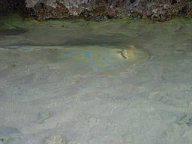
|
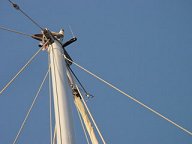
|
|
Although it was pretty windy all day, there seemed to be a bit of a lull in the mornings, when we would explore the various small islands in the marsa and watch the birds from quite close range. Our first evening it calmed down quite a bit and a fisherman came in and anchored by a sand spit. We decided to go over and say hello, as he was the only other boat in the anchorage, and took a few small fish hooks with us. The boat was small and completely open, with a large icebox in its centre, covered by a piece of sacking. The crew consisted of an old man and a boy, and to our delight the old man spoke English. We stayed alongside chatting for a while and he offered us a cup of tea, so the boy lit a fire in the bottom of the boat, and after about 20 minutes or so produced two glasses of sweet milky tea. We discovered that they came from Port Sudan and would be out for anything up to a week till they had caught enough to be worth returning the 25 miles back to the market there. Despite the icebox (which was just that - an insulated box full of ice) we realised why third world city fish markets often have so many rather dead looking fish in them. They seemed pleased with, or maybe touched by, the fishhooks, and it was amusing to see the young boy's amazement at the old man's ability to speak English. It transpired that he was working hard to make sure all his children got an education - he didn't intend that his sons should come fishing with him, and one was already in he Navy, as he himself had been. He maybe wasn't as old as we had thought, or had a young wife, as we learnt that she had recently had a baby after several miscarriages which were mentioned very casually, giving a small indication of Sudanese life and expectations. At dusk, we wished them well and left them to settle down for the night, which was quite cool, and cannot have been very comfortable in an open boat with no cover visible. The wind kept going, and forecasts being relayed from assorted sources all agreed that it would do so for some days. By radio we were talking to friends both ahead and behind us and most people within a hundred miles or so were waiting for a better forecast and sitting it out wherever they happened to be. So we were quite surprised to look up at midday and see two yachts coming into the anchorage, who were from the group we had almost joined on the way from Salalah to Aden and got to know a little more in Aden and Massawa - these were the Swedish yacht Xtra with Kjell and Gudrun and Monsun the cat, and the Danish yacht Bess with Neils and Stina and their young son Thomas. We waved and talked to them on the radio - with much more powerful engines than we have they had motored up against the wind and sea for a few miles to arrive at Marsa Fijab. This was our good fortune as we were all invited to Gudrun's birthday party on board Xtra the following night. Meanwhile, later that afternoon, I heard the sound of a boat approaching and looked up to find our fisherman just off the stern. The boy held out a bowl of steaming fish stew and some fresh rolls which they had brought over for our supper! Decanting it quickly so that they could go back and anchor (they must have hauled up specially to come over to us), we thanked them profusely and ate the delicious stew. We felt quite embarrassed to be accepting food but could clearly not refuse. The following day was Good Friday, whose English name we were unable to explain to our baffled friends, and the party on Xtra featured a vast spread of traditional Swedish food and featured the painting of boiled eggs by each of us, which we later ate. This was very generous of Kjell and Gudrun who later admitted that they were running quite low on stores by then. We had noticed the cries of glee at the sight of a couple of tins of tonic we had taken over with a bottle of gin - of gin there was plenty, but tonic was a luxury by then! Two more yachts had arrived by now, who we had last seen but not really met in Galle in Sri Lanka. We went over to say hello to the English yacht Hygeia and found that Kiko and Mia are practically neighbours in Hampshire. They had a very superior forecast which was specially prepared for them and which indicated that Easter Day was the time to set off again, and we all duly did. This time we made our way outside the barrier reef, hoping to get round Ras Abu Shagrab, a headland to the north of us and make some faster progress than our previous day-hopping. That night we held a short evensong before a special Easter dinner with wine, (not only now in short supply, but not normally drunk under way). We were making good progress, when the following morning, on the radio sched, Hygeia reported that their forecast had now been updated to warn that a north westerly wind was due to rise that evening, reaching 40 - 45 knots - gale force - within 24 hours. This is not one's ideal for windward sailing, so everyone listening looked for their most sensible port of call to be into by 2 or 3 pm, which is very frustrating on a day like this, when you are trying to make as much northing as possible and would ideally like to use all the available daylight! |
|

|
We found another marsa, with a reasonable entrance through the barrier reef first, and had to work quite hard to find our way in - even in good light it was hard to see all the coral shallows here, for some reason. Finding good holding was tricky too, but we finally found a good spot, made sure the anchor was well dug in, and then fretted at the still reasonable weather. There were lots of camels ashore, and we saw them being rounded up and driven off northwards. (The_Red_Sea_and_home_26). In this picture you can just see the change in water colour which indicates a reef in the browner areas. The following morning the weather didn't seem too bad, so we decided to make a very short hop up inside the barrier reef, which should give us sheltered water at least, to the next marsa. We were re-tracing our steps back out and were perhaps a third of the way when John realised that there was no cooling water coming from the engine. We turned round immediately and went back towards the anchorage, but just before we got back to our safe anchoring spot the engine began to boil and we had to anchor where we were. There was no chance this time to dig the anchor in, we just had to pray it would hold. Helen went over the side to see if something was blocking the water intake and found a jelly fish. After clearing it out, John had to take the sea water pump apart to replace the impeller which had disintegrated from the lack of water. While we had a hot engine, we decided to do an oil change which was needed at about this time and drew out much more oil from the engine than normal - because it had boiled dry! After about three hours, all was completed and working again, but during that time the wind had risen and we were pulling well back on the anchor and only three boat lengths away from a reef behind us. Since pure luck had found us some good holding, we decided to leave Flame where she was, but give ourselves additional security and time against a possible anchor drag by taking a line ashore to a boulder. We tied almost every line we had on board together - all our long Panama Canal lines came in very handy - and motored them up wind in the dinghy to tie round a handy rock, which we had to pad to avoid chafe. Hauling up on this line helped to keep some of the pressure off the anchor and so we passed the windy night. |
|
The wind had eased slightly the following morning when we tried again and were able to beat up inside the barrier reef to the next
marsa, just 10 ˝ miles away. It was worth doing, as we sailed 19 miles to achieve the 10 ˝! The following day was much the same, and we made our way almost into Egypt and to the jumping off point for the 160 miles across Foul Bay. This last Sudanese
marsa, Khor el Marob, was the longest of all with huge depths all the way in for more than two miles until one found shallow enough water in which to anchor. We were just glad that it wasn't here that the jellyfish had been drawn into the water intake as it would have been impossible to anchor in most of the
marsa. There has been no update to the extremely inaccurate survey also made by a lieutenant in the 19th century who is described in the modern pilot as having had an off day! After one day here when we tightened up the rigging ready for more windward work, we set off for Foul Bay with an unappealing forecast. The log notes: "Whether to proceed or abort this passage v difficult to judge. Forecast 25 knots NW at 24°N and building seas not a pleasant prospect". However we decided to press on and that night the wind dropped away completely, giving us a flat and for us quite fast passage motoring across most of Foul Bay. In the morning we heard from Hygeia, further north than us by now, that the wind had hit her at 0300, and that the sea had got up rapidly, so we realised that we would be very lucky to be in before it reached us. The northerly winds work their way down the Red Sea and reports from boats up ahead are generally the best forecast one can get. We prepared the boat, kept motoring and waited. At 0920 the wind started to rise and within 15 minutes was up to 25 knots, straight on the nose. We simply cannot motor into this, so while Xtra (who had re-appeared with Bess in Foul Bay overnight) reduced sail and increased throttle, we unfurled our genoa, switched the engine off and started tacking. It was our first real exposure to the very insistent strong winds and short steep seas that come up so quickly and give the Red Sea its alarming reputation, particularly with cruising sailors more used to downwind trade wind passages! The visibility quickly dropped and everything seemed to be shrouded in a haze of mist. We tacked back and forth and decided to take an inshore passage inside an island into our planned anchorage, just 16 miles away. The inshore passage proved a dubious decision because the chart we were using did not provide enough detail and it was only afterwards that Helen discovered the detailed chart we needed in the locker. John, at the helm for the rest of the day, with scarcely a break, suddenly called out "I think I've lost steerage - the helm is very sluggish". Helen, below at the chart table had heard a bang up forward, and went up on the foredeck to investigate. The working jib, which since we left home had lived tied to the lifelines when not in use, had filled with water, broken a fitting securing the lower lifeline and was in the water under the bow of the boat. It was impossible to pull it up out of the water as it had filled and was being held under the boat. We had to heave to (stop the boat in the water, under sail) on port tack to bring more of the sail out of the water by heeling the boat the other way, and this also allowed John to leave the helm and between us we managed to pull the sail back on board, and drag it back into the cockpit to stow. This short interlude allowed Bess, who was motor tacking, to pull well ahead, which later proved very helpful, though at first it was alarming to see how fast she had vanished into the murk. It took till 1620 to reach the anchorage and drop the hook. During the seven hours we sailed 28 miles to make good 16, and certainly tacked much more often than we needed to because of worries over where the reefs on each side of us were. Helen as navigator had no confidence in being able to see the reefs before hitting them in these sunless conditions and was trying to maintain a plot on the inadequate chart in between winching in the furled foresail every time we tacked, and receiving guidance from Bess on the radio. John on the helm, sailing Flame for all she was worth, was showing enormous fortitude in ignoring the echo sounder which showed apparently random depths between 60 fathoms and none, which quickly reduced Helen to a nervous wreck in the few minutes she was on the helm (the echo sounder is only visible to the helmsman on Flame.) Altogether it was a tiring day, made much worse by not finding the correct chart and by the proximity of the reefs. We might have been better off to go out to sea, although since the spell of weather lasted for 3 more days it would have been an uncomfortable ride, but less worrying and tiring than being so close inshore was for that relatively short spell. Once in the anchorage, where we found three other boats besides Xtra and Bess, we sat and had a good dinner (lunch had been honey sandwiches - very restorative in the short term!), and there we waited for three days until the weather abated. We had some difficulty when we came to get the anchor up as it was hooked round coral - the first time since the Tuamotus in the French Polynesia, but the water was very cold for swimming and by persistence and putting rather a strain on the windlass, we managed to get it up. We tacked offshore into a sea left choppy by the previous few days' blow, though the wind strength was down to a pleasant 10 - 15 knots. However we struggled to make progress through the seas, and in particular progress north - during one 12 hour period, we managed to make only 10 miles of northing! We found that we were not alone in this - anyone who was sailing was struggling, and it seemed that only those who didn't have big enough engines to motor, were sailing! But gradually the sea eased, and then of course the wind dropped, so that we had a combination of fairly gentle sailing, steering by hand to try to take every advantage of the wind and keep our course up, and some motoring. Because of the motoring we had to stop in an Egyptian marsa where fuel was available. Approaching the marsa, we could see on the shore a strange large white oval, with a blue lower rim. To our horror, as we made the final approach, we saw that it was a yacht, over on her side and wrecked on the reef just to the south of the entrance. It was the first time we had seen a wrecked yacht, and despite the presence of marker buoys for the channel, Helen was busy taking waypoints to be doubly certain of our way out. It transpired that the yacht had hit the reef attempting to enter the unlit marsa at night, when in company with three other yachts - the other two had made it successfully. Somewhat shaken, we were able to collect fuel (diesel priced at 10 US cents per litre!) and carry on northwards, by now motoring almost all the time, to reach a new safe marina in Hurghada the following evening, exactly four weeks and just over 1000 miles after leaving Massawa, our last port. And to make our arrival even better, it seemed that no sooner had we moored, than Ray appeared with Helen's hat! |
|
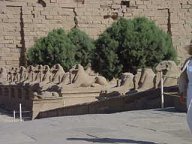
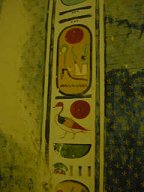
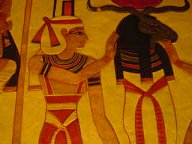
|
|
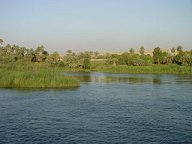
|
Here we left the boat, and teaming up with Sajudis again and Xtra, whose plans coincided almost exactly with ours, we all set off for Luxor, a (rather different) boat trip down the Nile to Aswan, a quick trip on down to Abu Simbel, and then the overnight train up to Cairo for a few days. We will not go into detail, since so many people have visited Egypt, but include a few pictures of Karnak; the fresh colours of the interior paintings in tombs in the Valley of the Kings and of the Queens; the wonderful fertile green-ness of the Nile valley, contrasted against the desert behind; the alabaster mosque in Cairo(The_Red_Sea_and_home_32); the oldest, "stepped" pyramid out at Saqqara (The_Red_Sea_and_home_33); and the delightful mashrabiyya screen in the Coptic museum in Cairo (The_Red_Sea_and_home_34). We had an excellent time together and it was a most successful trip. |
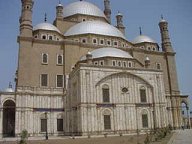
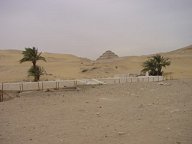
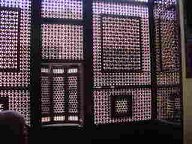
|
|
|
We were collected in Cairo and on the drive back down the Gulf of Suez to Hurghada were horrified to see another yacht aground on a reef. When we got back to the boat we learnt that two other yachts had also grounded, although luckily no-one was lost, and that in two cases, while still suffering from the shock of losing their boats, the crews were gaoled for damaging the coral! The wind was blowing again when we got back to Hurghada and there was much debate about when to clear out, not helped by the extraordinary restrictions on checking out times even between one port in Egypt and another. Finally a forecast suggested a good time to leave and we set off for our last leg up to Suez, hoping to get there in one go, but recognising that the previous weather window had closed when quite a few yachts were only 45 miles from Suez, and they had been weather bound for 6 days. We set off into quite a lumpy sea, heading up through a group of islands for the Strait of Gubal, at the entrance to the Gulf of Suez. The strait has quite a reputation for its seas and when we encountered them we wondered if we should find an anchorage and wait, the wind strength and sea state both being higher than the forecast. However we decided to press on. We tacked over to the Sinai shore, which is said to give better sailing conditions, and as charted found ourselves starting to thread between many oil rigs and other platforms and installations. The mountains on the Sinai peninsula were only visible at dawn and dusk through the general haze, but when they were, they were quite spectacular. When the wind eased we slowed down quite a bit, hampered by the choppy sea that remained, and at one point we confessed over the radio to our friends on Vagabond that our VMG (speed towards our destination) was only 1.5 knots - "but better than if we were at anchor!" But it still only took us just over 2 days to get up to Suez: we were able to sail on and off in between the oil platforms as the sea came down, but finally motored the last bit on a calm bright sunny day into the channel leading into the Suez Canal. We arrived as Egypt was celebrating Orthodox Easter - we had missed the highly recommended midnight mass the night before and now assumed everyone would be on holiday. However as we arrived at the yacht moorings provided at the entrance to the Canal, and to our delight finding Perdika still there, we were also delighted that we were able to be measured for the canal immediately, and then managed to arrange to go through the first half of the canal the following day. The passage through the Suez Canal from a yacht is fairly dull as one is too low to see the surrounding countryside. However many people were out enjoying the holiday - some waved, some seemed less welcoming - and we had a very pleasant pilot, not constantly demanding gifts, as some are said to. We arrived in Ismailia and here said goodbye to Perdika, who were pressing straight on the next day for the Mediterranean, having visited Sinai from Suez. The yacht club moorings at Ismailia are a fairly safe place to leave a boat so we decided to visit Sinai too, tempted by the brief sight we had had as we sailed past. |
|
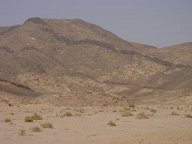 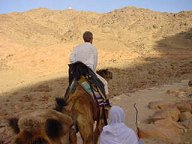
|
We found a car and driver who took us down to St Catherine's Monastery. The last part of the drive through Wadi Feran is spectacular, with rocks of many colours used for building and just scattered around - rust red, grey, cream, blue - with clear chocolate stripes running through some of the hills. We went straight to the base of Mount Sinai, though there seems now to be considerable doubt if it is Moses' mountain, and finding it quite deserted except for a few camel drivers, took a camel each for some of the way up. It is a very harsh landscape, with people leading simple lives that in some respects cannot have changed greatly from old testament times, though some mod cons are now available. St Catherine's Monastery is only open for limited hours, which results in extreme over-crowding. We discovered, too late, that it is possible to attend Vespers which is held at 4pm every day. Although one might see less, and certainly less detail, we felt that it would be a much better way to visit! But we did particularly enjoy the 6th and 7th century icons in the monastery's interesting small museum. |
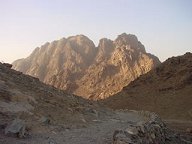
|
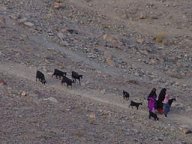
|
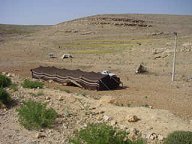
|
After exploring the wonderful scenery at the southern end of the peninsula a little further, (during we were interested to notice small mosques everywhere, provided for people working in remote petrol stations, army checkpoints and building sites miles from anywhere) we took the fast ferry up the Gulf of Aqaba to Jordan. There we hired a car, and drove up the excellent road from Aqaba to Petra. You drive through the desert with massive bouldered hills rising around you, steadily climbing up through the stark hills spreading out ahead. As we came off the main road, we must have been at the watershed of Jordan, with views in all directions over hills, desert and now also fields which were still just green in May, where Bedouin still camp in the traditional way, with their flocks of sheep and goats, but with four wheel drive vehicles as well as camels for transport! As we neared Petra, the landscape was an extraordinary combination of fertile grassland on the tops of smoothly rounded hills lying immediately above ferociously jagged, hostile and quite barren rock cliffs and gorges. Finally the road leads around the rim of the deep valley in which lies Petra, the hidden and once forgotten city of the Nabateans. |
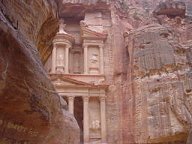 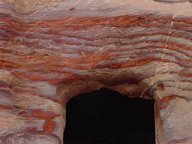
|
Petra was a delight for us - the more so as it was almost totally empty, and has been since the intifada began in Israel several years ago. (While Egypt was said to have lost many visitors since September 11th last year, it was still crowded - there really was hardly anyone at Petra). Again we are including just a few photos - of the first view of the Treasury from the narrow Siq ; of the extraordinary rock colours, which make Sinai look quite dull by contrast; and of one of the delightful mosaics in a Byzantine church which was recently uncovered. We spent a full day and a half at Petra, before heading south again to Aqaba, stopping at Wadi Rum on the way. Wadi Rum was used by TE Lawrence during the Arab Revolt, and is a most spectacular example of desert scenery. These are the rocks near the entrance to the wadi which are said to have been named the Seven Pillars of Wisdom by Lawrence (The_Red_Sea_and_home_45). We took a guide and a four wheel drive late in the afternoon to explore a little and watch the colours intensify as the sun set, when it got really quite cold, as you can see from the hunched shadows (The_Red_Sea_and_home_44). We stayed for a simple picnic cooked over a fire as it got dark, and, as when well out at sea, it really was dark, with wonderful stars seen this time from an unmoving platform! |
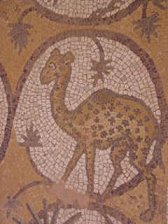
|
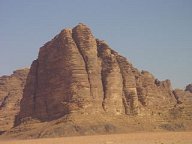
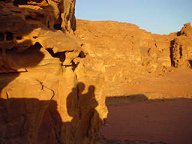
|
|
We made our way back to Ismailia and saying goodbye now to Vagabond who had arrived in our absence, left as soon as we could for the Mediterranean. We were much less lucky in our pilot this time, and he constantly complained that we would not drive the engine at full revs to get him home early. We were relieved to put him ashore at Port Said and carried straight on out into our "home" sea, the Mediterranean! The sea was lumpy, though less steep than the Red Sea had been, and we were able to negotiate most of the huge amount of canal shipping before nightfall, and set off into a north westerly wind, which meant that we were forced to head for southern Cyprus, and even for Beirut at one point, quite the wrong direction. |
|
|
The wind however gradually backed, helping us to steer a course which curved towards Antalya, with occasional boosts followed by calms, so that we made rather uneven progress. We had been so fortunate on the whole trip that Helen became quite nervous about tempting fate at this late stage and refused to give any ETA until we were within sight of the harbour! We had quite forgotten how beautiful the mountains are approaching Antalya, and that added to the wonderful feeling as we were welcomed by Zafer, the marina manager, on the radio, and motored back in through the breakwaters at 1930 on May 21st, a little over two years after we had left. |
|
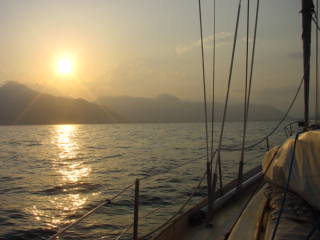
|
|
|
A number of yachts we knew had arrived ahead of us, and there were cheers and congratulations from them as we came into the marina, to be welcomed by Sajudis and Xtra and straight into a drinks party, followed by coffee with Zafer and then dinner. |
|
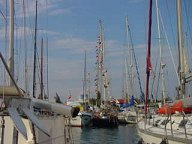
|
It was lovely the following morning to meet old friends on the marina staff and to be able to relax properly, with only Flame to pack up, and flights and luggage left to organise. |
|
28,000 miles, 26 months and 39 countries later, having left Antalya one fine April morning, we completed our circumnavigation. The experience and the new sailing friends, the places and all we did will make wonderful memories. We hope these reports, late as they are, have managed to give you a feeling for it all. We would like to thank David Stoves for suggesting, designing, building and maintaining this web site. Many of you have been very complimentary about its operation, and you should know that David is now available on a freelance basis, at very reasonable terms, to assist in other web based projects. Both down to earth and knowledgeable, it would be hard to find someone better to work with on such a project. Click
here if you would like to contact David directly through his company
Datavu. |
|
|
|
|
| Return to Home Page | |
| Previous bulletin - 31st July 2002 | |
| Start of voyage - You can read each bulletin in turn | |
| Ship's Log Index | |
| There are some additional pictures from this part of the voyage in the gallery | |